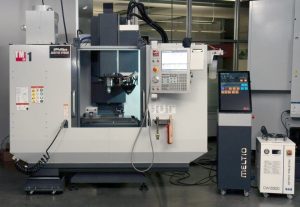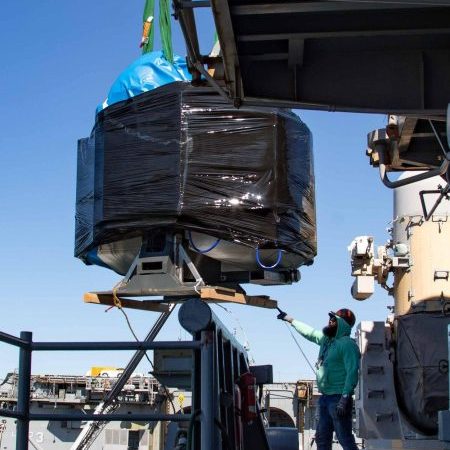The amphibious assault ship USS Bataan (right) is the flagship for the Bataan Amphibious Ready Group. (Photo by Mass Communication Specialist 1st Class RJ Stratchko/Released).
The Spanish multinational Meltio -a disruptive wire-laser metal 3D printing technology manufacturer– together with Phillips Corporation – a global manufacturing solutions leader based in the US – have worked together to install for the first time on a US Navy ship a metal 3D printing solution for the onboard manufacture of spare parts and repairs. The Phillips Additive Hybrid powered by Haas took the laser metal deposition technology of Meltio and integrated it with the world-renowned Haas CNC vertical machining centers control mill onboard the USS Bataan ship.
Text by Phillips Corp.
This new project represents a further step towards demonstrating an industrially useful application in the marine sector thanks to the accessible wire-laser metal 3D printing technology developed by Meltio. The Hybrid system provides subtractive and additive manufacturing. The US Navy is using a combination of these in this particular project for the USS Bataan ship.
The Phillips Additive Hybrid system prints 316L stainless steel, a prevalent material in US Navy ship systems. While stainless steel additive manufacturing onboard naval ships is new, it also represents an advancement in providing sailors with industrial-level manufacturing capabilities to print individual parts for systems that previously have not been readily available without procuring the entire system at a significantly greater cost. The equipment, installed under a joint effort between the Commander, the Naval Surface Force Atlantic, and the Naval Sea Systems Command (NAVSEA) Technology Office, includes the Phillips Additive Hybrid system, which integrates a Meltio wire-laser metal deposition head on a Haas TM-1 computer numerical control mill. The Haas TM-1 platform has been proven to operate reliably in an afloat environment aboard several aircraft carriers. Integrating the Meltio deposition head with the Haas TM-1 provides both an additive and subtractive manufacturing capability within the same system – increasing efficiency and reducing waste when compared with typical machining.
Spare parts & repairs
Ángel Llavero, CEO of Meltio, says: “For us, the fact that the US Navy has incorporated Meltio’s wire-laser metal 3D printing solution and Haas hybrid equipment thanks to Phillips Corporation on board the US Navy ship to manufacture spare parts and repair them is the consequence of years of effort and a great vision that we had at Meltio. We would like to thank Phillips Corporation for their support in the development of these hybrid systems under the Haas brand, which is the consequence of confirming a technology with enormous industrial applications in the naval and marine sector, in defense, and in all those industrial sectors where it is necessary to be able to manufacture the part when and where it is needed. We are sure that this is the first step in a long way that we will have in this industrial sector of the navy with this and other applications”.
Point of need production

(Photo by Phillips Corporation).
The US Navy advanced efforts to improve self-sufficiency for deployed ships and their crews and reduce supply chain lead times by leveraging additive manufacturing (AM) by permanently installing the first metal 3D printer aboard a ship.
Thanks to additive manufacturing, the engineers will join different materials to make parts from 3D model data, usually layer upon layer, as opposed to subtractive manufacturing and formative manufacturing methodologies. Whether creating a quality-of-life item or a sophisticated machine part, AM facilitates production at the point of need when time and operational availability matter.
“The introduction of additive manufacturing (AM) into naval operations supports readiness and self-sufficiency,” states Rear Adm. Brendan McLane, commander, Naval Surface Force Atlantic. “These printers have the ability to help the Navy overcome both obsolescence issues for ships and systems that have service lives measured in decades and directly contribute to enhanced operational availability of our systems and ships,” says NAVSEA Chief Engineer Rear Adm. Jason Lloyd.
Double benefits

The Meltio’s Engine 3D printing benefits are two fold – it maximises operational availability and reduces the demand on traditional and Navy-specific supply chains.
Additionally, NAVSEA engineers installed a second 3D printer to produce polymer (plastic) components onboard Bataan. This printer enables the ship’s crew to print any of the NAVSEA-developed 300+ AM Technical Data Packages that define the required design configuration and procedures to manufacture a part and ensure it performs properly.
“Phillips and Meltio are proud to be a part of Phillips Additive Hybrid installation aboard the USS Bataan. This is the first laser metal deposition (LMD) additive manufacturing technology installed aboard a naval ship” said Brian Kristaponis, General Manager, Phillips Corporation, Hybrid Division. “This is an optimal fit for the US Navy that is seeking to add exceptional new Additive capability to their Haas machining centers– all in one machine” Kristaponis added. “They are leveraging this exciting new technology to improve self-sufficiency for deployed ships and their crews.”
Amphibious assault ship
Bataan, a multi-purpose amphibious assault ship, carries more than 2,500 Sailors and Marines when fully embarked, and is the fifth ship of the Navy’s Wasp-class ships. She was commissioned on September 20, 1997, and is the second U.S. Navy warship to bear the name. NAVSEA is the largest of the Navy’s six system commands, responsible for the building, buying, and maintaining of ships, submarines, and systems for the U.S. Navy. NAVSEA’s Technology Office is leading multiple areas of research and development in the evaluation of AM equipment, using data not only from deployed assets but also from shoreside lab activities, to gain a critical understanding of how the equipment will perform under shipboard conditions.
About this Featured Story
This Featured Story appeared in Stainless Steel World October 2023 magazine. To read many more articles like these on an (almost) monthly basis, subscribe to our magazine (available in print and digital format) – SUBSCRIPTIONS TO OUR DIGITAL VERSION ARE NOW FREE.
Every week we share a new Featured Story with our Stainless Steel community. Join us and let’s share your Featured Story on Stainless Steel World online and in print.


